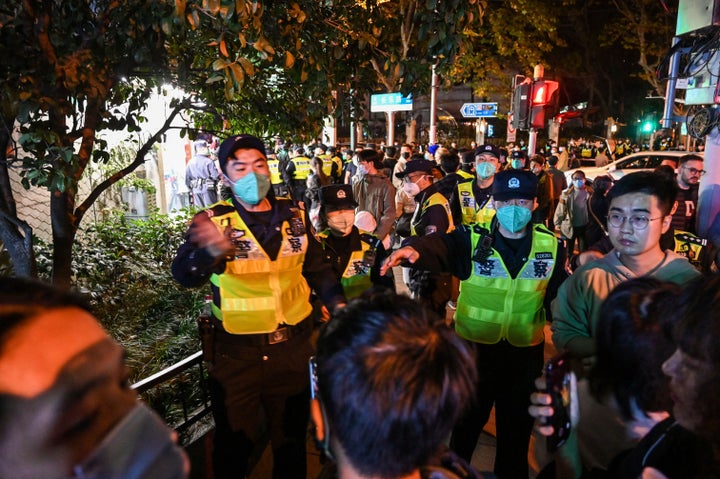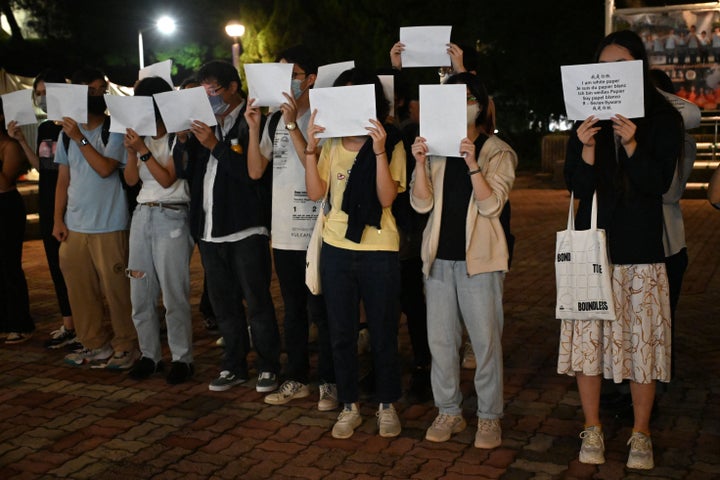Protests have rocked China over the weekend as the public push back against ongoing strict Covid measures – with some even calling for a new president.
Such pushback against the country’s authoritarian Communist Party has not been seen since the 1980s.
As the population is on the cusp of entering its fourth year of Covid restrictions, thousands have flocked to Beijing, Shanghai and Wuhan streets calling for immediate change.
Here’s what you need to know.

What’s happening at the protests?
Thousands in major cities across China are bravely standing up to the government and its stringent Covid measures.
Having started in Xinjiang, the local government’s refusal to lift Covid restrictions triggered residents from around the country to protest.
Many carry a blank piece of paper as a sign of dissonance in reference to the censorship from the Chinese government, and chant: “Need human rights, need freedom.”
Some have even called for a regime change, and for president Xi Jinping – who just secured a third term in office – to resign.
Others sing The Internationale, a socialist anthem also used during the pro-democracy protests in Tiananmen Square in Beijing before a severe crackdown from armed troops in 1989.
CNN believe there are demonstrations in at least 16 locations across the country, including to university campuses.
China’s financial capital Shanghai is particularly resentful, as a two-month lockdown earlier this year left people without access to food, medical care or other essentials.
International vigils and demonstrations (such as in London and Sydney) have shown solidarity with the protesters.
What are the protests about?
China has just upped its Covid restrictions again as part of its Zero-Covid policy, following an uptick of infections in all 31 provinces.
It has reported the highest number of Covid cases across the country since April, with 40,052 infections – but this is still very low compared to most other countries. It also just recorded its first Covid-related death in six months.
As Covid first became a significant health issue in the Chinese city of Wuhan, the country has endured strict social distancing policies ever since it was discovered in 2019.
Now years later, the general public are growing increasingly frustrated that their lives are being so curtailed.
Current ruling means local authorities have to impose strict lockdowns even if there are only a few Covid cases detected.
Mass testing is then mandatory in places where the cases have been found, while people with Covid have to be isolated at home or placed under quarantine at government facilities.
Businesses and schools have to be closed in these areas too, along with all shops (aside from those selling food).
The lockdowns have to stay in place until there are no new Covid cases found – meaning millions are living under a form of lockdown.
A couple of rules have been slightly relaxed in recent weeks. For instance, international arrivals are allowed for the first time since March this year, and isolation has been reduced to eight days in total.
But, it’s still far from the freedom every other major economy is allowing its public to have, and has had significant damage on the lives of every person in China.

What was the final trigger for the mass protests?
It’s widely believed that the main catalyst for the frustration was a fire that started in Xinjiang.
Ten people died while stuck in a high-rise building, prompting speculation they could have been saved had it not been for the Covid rules inhibiting rescue efforts.
The city had been in lockdown for more than 100 days at the time, with people unable to leave the region and many forced to stay in their own homes.
The region is already under scrutiny for allegedly detaining up to two million Uyghurs and other ethnic minorities, and for imposing an intense surveillance network although China has denied breaching any human rights.
Frustrations were likely exacerbated by the World Cup too. Fans who make it onto the live broadcast from Qatar are not practising any social distancing measures in stark contrast to the vast majority of the Chinese population.
While Chinese state TV has tried to censor any footage of these carefree fans without face masks, standing close together, a few have snuck through over the last week.
What is this so important?
Protest rarely happens in China. The last significant act of rebellion against the government was in 1989 in Tiananmen Square. This was shut down cruelly by the Army at the time.
Localised protests are more common, as they tend to just criticise local officials, instead of the centralised government which is known for quickly quashing any sign of dissent.
It was clear frustrations were growing in October, when anti-zero Covid slogans were graffitied in public places.
How has the government responded?
There’s been an intense crackdown. Some protests ended peacefully, but in Shanghai there were clashes between police and demonstrators, with videos capturing violent pushback.
BBC journalist Edward Lawrence was arrested on Sunday night. The BBC claimed he was “beaten and kicked by the police” while covering the demonstrations.
China later acknowledged it had happened but claimed that the journalist had not said he was part of the press.
The government was dismissive when pressed by reporters about the protests, saying: “What you mentioned does not reflect what actually happened.”
It also refused to acknowledge any protesters had called for Xi’s resignations.
What is the impact of the Zero-Covid policy?
This policy – which means implement strict rules wherever a Covid case is found – is having a grave impact on the country as a whole.
Around 5.8 million people who may need intensive care treatment if the Covid-Zero policies are dropped, according to Bloomberg’s calculations, because of delays to health care.
Then there’s the country’s economic slump, having grown by only 3.9% over the last year. Its target for the year was 5.5%.
Unemployment is on the up, the property market is struggling, and international businesses and consumers who rely on China are being affected.
The World Health Organisation (WHO) has called for China to change its approach too, with director general Dr Tedros Adhanom Ghebreyesus claiming the current approach is “not sustainable”.
What might happen next?
Winter also means Covid cases are probably going to increase, too – so this could mean the government is even more reluctant to make a policy change.
While the local government of Xinjiang, where the protests began, have already promised to lift the lockdown in stages, but it has not provided any clear timeline.
International bank Goldman Sachs has given China a 30% chance of reopening before the second quarter of 2023.
There have been calls for China to focus on its vaccination programme instead.
Only about half of people in China aged 80 and over have received their first vaccinations and less than 60% of those ages 60 to 69 are fully vaccinated.
The country uses its own home-grown vaccines Sinovac and Sinopharm, which may be less effective than ones used around the rest of the world such as Pfizer against Omicron, the current dominant strain.
And, Beijing continues to refuse offers from other countries to sell more effective jabs, with no official explanation.
Xi has also said the Zero Covid policy is “scientific and effective”, and claims it has saved lives because uncontrolled outbreaks would put vulnerable people at risk.
The official death toll is just over 5,200 since the pandemic began, meaning only 3 Covid deaths for every million people in China. In the UK, this is 2,400 per million and the US, 3,000 per million.
There’s also a chance that if Xi were to change his approach, his authority in China would be undermined, putting his premiership on the brink.

